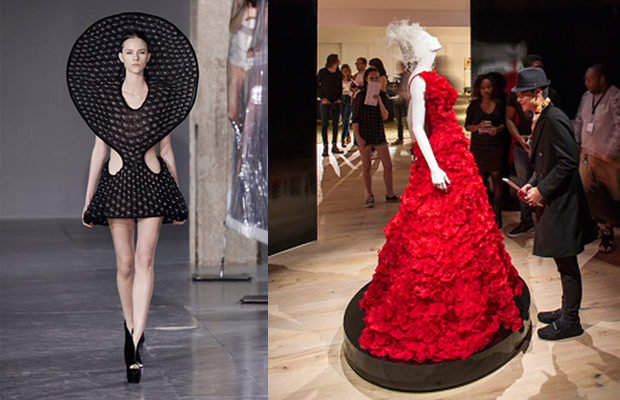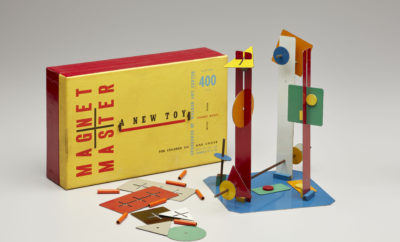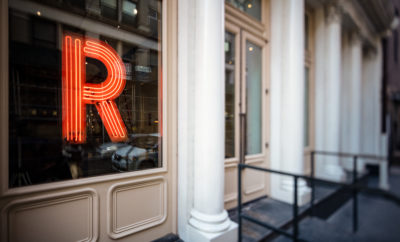 Iris van Herpen | Angelo Seminara and Millie Schwier making the wigs and floral headpieces for “FP04: The Anniversary.” Photo: Thom Atkinson.
Iris van Herpen | Angelo Seminara and Millie Schwier making the wigs and floral headpieces for “FP04: The Anniversary.” Photo: Thom Atkinson.
Exhibition
Fashion Forward: When What We Wear Becomes Art to See
COLLECTORS AND CONNOISSEURS OF DESIGN look for inspiration in many places, from the hardware store to the runway. This winter, fashion design comes into sharp focus with exhibitions that look at yesterday, today, and tomorrow. “Fashion is one of the most accessible of design disciplines, since we all use it, or we choose to reject it. Although it’s accessible, it’s not necessarily simplistic,” says Cathy Leff, the founder of the small jewel-like gallery installation called the Fashion Project at Miami’s Bal Harbour Shops. “Clothes carry many messages and narratives—about the maker, the wearer, lives lived, cultural attitudes, norms, and values. Examined in the broader context of an exhibition, dress speaks about the people who created and wore it, how they lived, what they did, the materials they used or worshipped,” Leff says.
The Fashion Project is arguably on the smallest scale of any of this winter’s fashion exhibitions, but it comes with a high pedigree. Leff, the former director of the Wolfsonian – Florida International University, was offered gallery space at the tony Bal Harbour Shops and then enlisted the help of the widely respected British curator and fashion design scholar Judith Clark. It’s a small space but perfect for a close look at the history of fashion, told in a series of exhibitions that are part curation and part conceptual art installation. In the fourth of the series, entitled The Anniversary, Clark looks at the last fifty years of fashion history with a special emphasis on nature as a design motif. The Anniversary runs through January 20 and will culminate with a four-day film festival, Fashion in Film/Time: Returns, Recalls, Renewals. fashionprojectbhs.com

Angelo Seminara and Millie Schwier making the wigs and floral headpieces for “FP04: The Anniversary.” Photo: Thom Atkinson.
In Atlanta, the High Museum’s Iris van Herpen, on view through May 15, 2016, showcases the experimental work of the thirty-one-year-old Dutch designer, who is influenced by art, science, music, and philosophy. Her oeuvre is at once based on traditional craftsmanship and new technology, including some of the world’s first 3-D printing in fashion and computer modeling and engraving, and at times it incorporates such unexpected materials as magnets and umbrella ribbing. Coorganized with the Netherlands’ Groninger Museum, the exhibition opened in November. Sarah Schleuning, the High’s curator of decorative arts and design who co-curated the exhibition, terms the work “an incredible fusion of artistic expression, craftsmanship, and creativity. The marriage of traditional, handcrafted designs and twenty-first-century technology makes her work innovative, dynamic, a bold, new future for fashion design.” highmuseum.org
The new SCAD FASH, opened in October by the Savannah College of Art and Design, adds a ten thousand-square-foot museum to the school’s Atlanta campus, joining with the art museum, which opened in 2011. The mission, according to SCAD president Paula Walker, is to focus “on the past, present, and future of fashion design, connecting conceptual to historical principles of dress, whether ceremonial, celebratory, or casual.” SCAD FASH opened with a retrospective exhibition of the work of Oscar de la Renta, looking at the designer’s career from the mid-1960s until his death in 2014 with additional garments from the fashion house’s current creative director Peter Copping. On view to December 31, the show includes gowns worn by Laura Bush, Taylor Swift, and Oprah Winfrey. The museum’s permanent collection also includes work from such designers as Yves St. Laurent and Givenchy. scad.edu
Jacqueline de Ribes: The Art of Style, on view through February 21, 2016 at the Metropolitan Museum of Art’s Anna Wintour Costume Center, looks at the fashion persona of the Countess Jacqueline de Ribes, both muse and designer, and in many ways, a living work of art (as curator Harold Koda puts it, her approach to dress was “a kind of performance art”). The exhibition features some sixty works taken from de Ribes’s archives and dating from 1962 to the present, including examples of her personal fancy dress ball ensembles. Though she put together her ball gowns and other attire herself, sometimes with the help of a seamstress, de Ribes was the celebrated client of many of the last century’s most important fashion houses (the Met’s list includes Giorgio Armani, Pierre Balmain, Bill Blass, Marc Bohan for House of Dior, Roberto Cavalli, John Galliano, Madame Grès [Alix Barton], Valentino Garavani, Jean-Paul Gaultier, Norma Kamali, Guy Laroche, Ralph Lauren, Ralph Rucci, Yves Saint Laurent, Fernando Sanchez for Révillon Frères, and Emanuel Ungaro). She had her own fashion house from 1982 to 1995. metmuseum.org

Jacqueline de Ribes, courtesy of The Metropolitan Museum of Art.
“Clothes speak about the individual and about society—class, gender, economics, politics, power,” says the Fashion Project’s Leff. “After all, we dress ourselves each day, and, in doing so, we construct and convey a bit of our identity—that is, who we are or who we want to be.”












